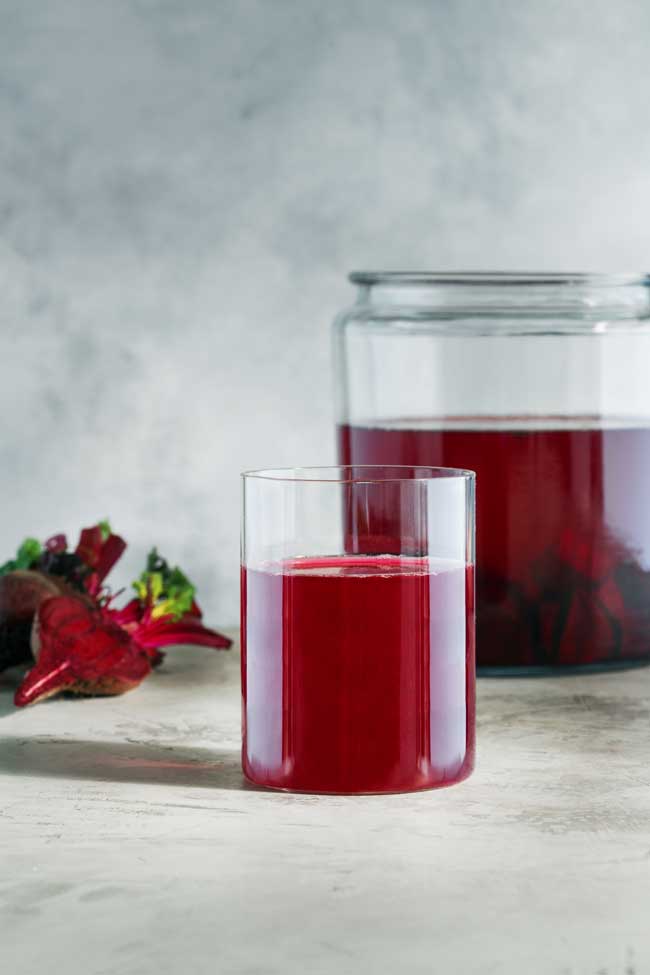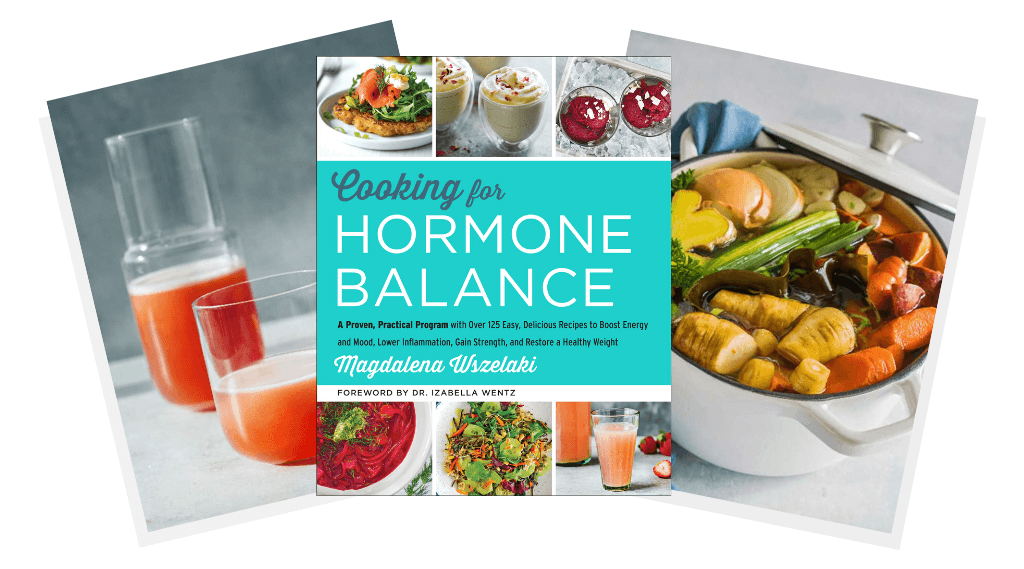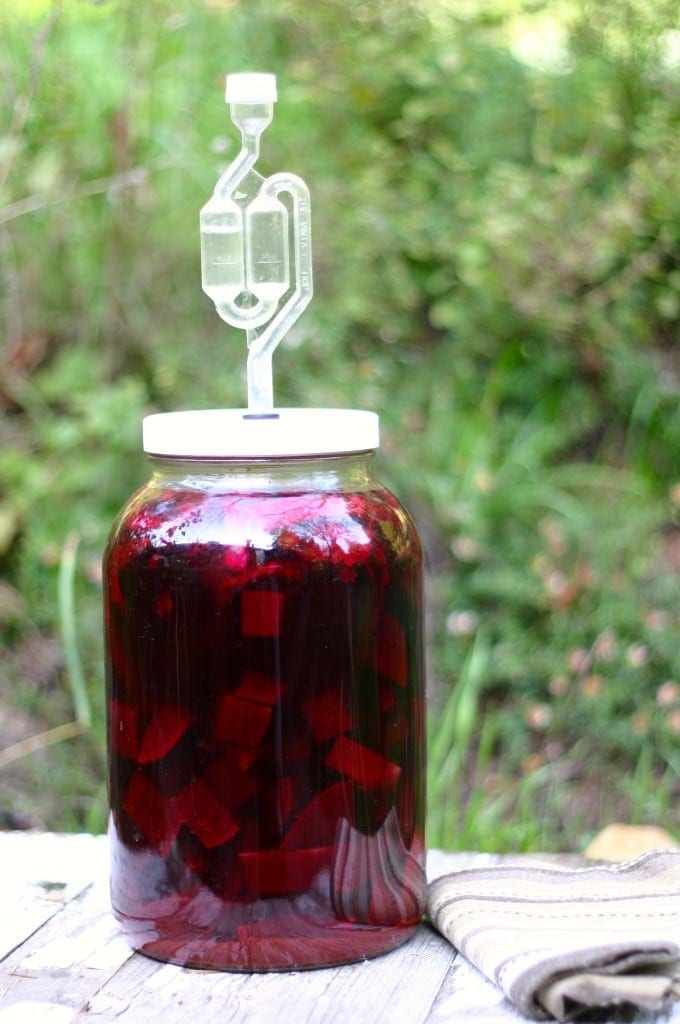
A traditional fermented Eastern European drink gets an upgrade with my probiotic beetroot tonic recipe. This recipe is a version of “kvass,” which means “acid” in Russian.
Originally, kvass was made from stale rye bread crumbs—instead of throwing them away, the bread was kept in salted water till it developed its own specific flavor. Kvass has evolved and today’s common way of making it is with beetroots, but I personally find kvass made with beetroot alone to be too earthy and bland. In my own culinary experiments, I’ve found that by adding zesty ginger, lemons, oranges, kumquats or tangerines, this drink becomes rather tangy and addictive.
Why is kvass so good for you? Sally Fallon in Nourishing Traditions says: “This drink is valuable for its medicinal qualities and as a digestive aid. Beets are just loaded with nutrients. One 4-ounce glass, morning and night, is an excellent blood tonic, promotes regularity, aids digestion, alkalizes the blood, cleanses the liver and is a good treatment for kidney stones and other ailments.”
Learn how to add more hormone-balancing ingredients to your meals with our FREE 15 Breakfasts to Rebalance Your Hormones guide here.
- 3 quarts/liters of water
- 1 tablespoon sea salt
- 3 beetroots, chopped (peel if not organic and if organic, leave the skin on)
- 1.5 limes with rind, quartered
- 2-
ich ginger knob, shredded - ½ pound cabbage, shredded
- 1 tablespoon turmeric powder
- 1 packet Body Ecology Starter
- Place all the ingredients in the fermentation vessel and give them a good stir to dissolve the salt.
- Weight the food down so the ginger and lime do not get moldy when they float to the top.
- Keep the vessel either covered with a
cheese cloth or place an airlock over it. We want the gas to be able to escape the vessel. Keep in room temperature (60-64F) for 4-5 days.- Strain and transfer to airlock bottles for a week, place in a cooler place (38 to 40F) for a week.
- When ready to drink, if you want extra carbonation, leave it out for a few
hours in room temperature. You can chill it before serving.
Low-FODMAP: replace beetroot with raspberries.
Tips
Kvass is a bit like wine - it takes time to develop its full flavor. I recommend to keep it in the fridge (the second part of the fermentation process) for as long as a week for the salty flavor to soften and for the ginger and the citrus to come through.

My version of beetroot kvass is vibrant, zingy, and packed with probiotics. You can find more recipes like it in my cookbook, Cooking For Hormone Balance, with over 125 easy, delicious recipes to nourish your body and balance your hormones without calorie restriction or deprivation.
All of the recipes are based on twenty hormone-supporting superfoods and twenty hormone-supporting super herbs—with modifications for Paleo, Paleo for Autoimmunity (AIP), anti-Candida, and low-FODMAP diets. Get the cookbook here.

Do I need to add the probiotic? I heard your recent talk at the hormone wellness summit, but I don’t remember you mentioning a probiotic.
The body ecology is the starter for this-yes.
Hello! Great recipe. I have about one more day (Day 5) to complete my fermentation of the Beet Kvaas. There is a bubbly-looking type of white film forming a couple of inches below the cheesecloth I have over my jug. Should I scrape it off? It doesn’t look moldy, just smells a little “different” to me. (This is my first ever fermentation.). Thanks very much. All the best!!!
Google kahm yeast and see if the pictures match. If it is kahm you can scrape it off, it’s not toxic, however it can affect the taste unfavorably.
I need help from someone in South Africa, where I live. Do you know of anyone?
Thank you for sharing here~Deanna HB Team
Yes!
Hi! I am looking for Body Ecology starter but I only get Body Ecology kefir starter online. Are they are the same ?
Thank you.
Gina
Hi Gina,
Here is a link to the culture you will need. https://bodyecology.com/weight-loss-vegetable-culture-starter.html?___SID=U
Angela HB Team
Hi!
Can I drink this?
Because I am dialing with fibroids .
Gina R.
Hi Gina,
Yes you will be able to drink the Kvass. Have you watched Magdalena’s free workshop? You might be interested. She talks about fibroids. http://www.cookingforbalance.com
Kindly, Angela HB Team
I can’t get the link to work that is located under your beetroot kvass recipe. When you list the ingredients the last one is a “body ecology starter” the word sources is in blue like a link but when I click on it nothing happens.
I’m not sure if it’s my computer or if it’s the link.
Hi Elizabeth,
I’m sorry you are having trouble with the link. Here is the link for the culture, https://bodyecology.com/weight-loss-vegetable-culture-starter.html?___SID=U
Angela, HB Team
Hi,
Where do I find the items to ferment, meaning the jar and lid like the picture?
HI Kathie,
The cultures can be found at Body Ecology and Cultures for Health along with the lids in the photos. Let us know how your ferments go as you get started.
Warmly, Angela HB Team
If substituting raspberries what quantity should I use?
Hi Rhonda,
You can substitute 1 pound of raspberries for the Low FODMAP compliant version of this recipe. Let us know how it turns out for you.
Angela HB Team
Hi,
I’m very excited to make this but what if my room temperature is more like 76 – 78 F?
Thank you,
Hi Jenn,
It will most likely need to be a little cooler to have it turn out well.
~Deanna HB Team
Can you use whey in place of the starter?
Hi Lisa, yes you can use whey if you are not sensitive to it. Here is a kvass recipe that included whey: https://wellnessmama.com/9087/beet-kvass/
I hope this helps!
~ Jeanne HB Team
[…] Fermented beets: Kvass, a tasty fermented Eastern European drink is made from chopped beetroot, turmeric root, water and salt, resulting in a lactobacillus fermentation. It is a super healthy probiotic drink that does not contain yeasts like Kombucha, so it will not worsen candida overgrowth. Check out my kvass recipe here. […]
Thank you for the recipe!
You said kvass is like wine and takes time to develop the flavour. Ddes it mean it doesn’t expire? How long can I keep it in the fridge?
Thank you.
Hi Grace,
I typically enjoy kvass for 7-10 days,
Enjoy!
HB team
What do you use to weight down the veggies on top? I made this years ago and tossed out the whole jar because I was concerned that there was mold. But it was probably perfect. I never attempted it again because of that until maybe now maybe 10 years later.!
Hi Wendy, you can buy weights to hold the veggies down. The are used for pickling and fermenting. Kitchen stores and online retailers carry them. Have fun trying it out again.